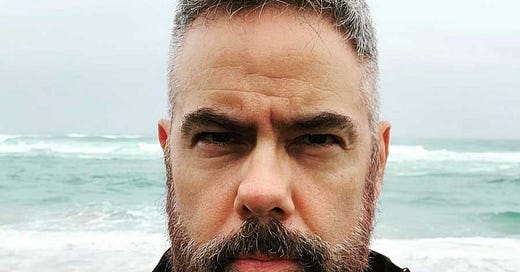Hello folks and welcome to another episode of Inside The Newsroom, where today’s guest is the hurricane man himself, Mr. Josh Morgerman. I had Josh and his director Caroline Menzies on the pod last year to talk about their hit TV show, Hurricane Man (highly recommended watch) which followed Josh to the world’s most remote places during the infamous 2018 cyclone season. This time around Josh’s setup was dramatically altered by Covid-19, so we caught up on this year’s hurricane season of which he spent in Mississippi.
As ever be sure to check out last weeks’s coverage outside the newsroom, with Inside The Middle East and Picks of the Week. And if you’re a fellow weather geek, enjoy some of my previous podcasts…
Job Corner
We finally did it, 1,000 journalism jobs and internships! This week’s new postings feature the likes of CNN, the Economist and the Wall Street Journal. Keep spreading the word! 🙏 👇
Data Corner
Cyclone Activity: Real-time data for all major ocean basins around the world, from Colorado State University
Who is Josh Morgerman?
Josh was born and raised in New York, studied history at Harvard and now resides in L.A. where he runs his own branding consultancy company. Yes, not the typical route to becoming one of the world’s leading storm chasers. As Josh puts it, he was born to chase, which is why Josh has spent the past few months in Bay St. Louis in Mississippi, so that he’s just a drive away from this year’s hurricane action amid international travel restrictions. In non-Covid years, Josh has travelled to some of the most remote areas in the world to capture valuable data for scientists and academics to study.
Josh has been chasing storms for the best part of the past 30 years, but it was last year that shook him to his core. Chasing the most powerful hurricane on record to make landfall in North America led Josh to the Bahamas, where he intercepted Hurricane Dorian head on. When the worst of the storm had passed, not much was left standing, and there was a gut-wrenching 48-hour period when no one could reach him and he was presumed dead. While Josh didn’t study meteorology in college, he’s certainly a student of the field, so we’ll quickly run through some key terms we’ll use in today’s newsletter…
Correction: I originally stated that Hurricane Dorian was the most powerful hurricane on record. It’s not. It’s the most powerful to make landfall in North America.
The Hurricane Man 👇
Quick Glossary
What’s the difference between a cyclone, hurricane and typhoon?
A cyclone is the generic term for a rotating storm, and also the name given to large-scale rotating storms in the Southern Hemisphere. Under that generic label we have hurricanes, which are large-scale rotating storms in the North Atlantic and the Northeast Pacific, while a typhoon is the equivalent for large-scale rotating storms in the Northwest Pacific.
What is Accumulated Cyclone Energy?
Commonly known as ACE, it measures multiple metrics including wind speed and the number of days a storm lasts in order to give an overall impact.
What are the different cyclone basins?
The major ocean basins include the North Atlantic, Northeast Pacific, Northwest Pacific, North Indian, South Indian and South Pacific.
What Are the Differences Between the Northern and Southern Hemispheres?
Key differences between the north and south include the time of year each has its season: In the north typically between June and November, and in the south typically between December and April. Cyclones in the north rotate counterclockwise, and clockwise in the south due to the Coriolis effect.
Support Independent Journalism
Hey there, each podcast episode and newsletter takes around 12 hours to put together. If you’ve enjoyed today’s episode, please consider subscribing so we can continue delivering you the most important news from around the world 🙏
Record Year in the Atlantic
Now that we know that there are multiple ocean basins around the world, let’s take a look at this year’s activity in each so far. You may have heard that the 2020 North Atlantic season has seen a record number of named storms — a storm with winds of at least 39mph — with 30, beating the previous record of 28 set during the ominous 2005 season. What also sets 2020 apart is the fact that we’ve seen a category 4 hurricane in four consecutive months (August to November).
Two more notable anomalies from this season: The last time we saw two hurricanes in November was in 2001, which saw a category 4, and two category 1s including Olga that dipped her toe into December (also extremely rare). Fast forward to 2020 and the category 4 Hurricane Eta and category 5 Hurricane Iota both followed almost identical paths and slammed into Nicaragua, adversely affecting the likes of Honduras and El Salvador as well. While the National Hurricane Center is watching a disturbance currently trying to form, fingers crossed we can close the book on the 2020 North Atlantic hurricane season.
What About the Rest of the World?
While the Atlantic has seen several records broken, overall activity in the Northern Hemisphere this year has been below average. The good folks at Colorado State University track activity in all the world’s major ocean basins, and thankfully the number of storms and ACE (see glossary above) is way down in the Northeast Pacific, which experienced its highest ACE on record in 2018, and the Northwest Pacific, which saw an insane five typhoons last year in November alone.
Elsewhere, the Southern Hemisphere’s cyclone season is just starting…

Climate Change?
It’s the elephant in the room any time there’s a major hurricane, and it would be extremely negligent not to discuss climate change any time there’s a severe weather event. But that’s where things become extremely complex and we must contextualize wherever we can. The first thing we must decipher is the difference between meteorology and climatology, which are intertwined yet fundamentally different.
Meteorology is the study of weather, most often on a day-to-day or even season-by-season basis. For example, we know that there were a record number of named storms in the Atlantic this year. Climatology, on the other hand, is the study of meteorology over an extended number of years. In order to conclude whether climate change makes hurricanes worse, we must look at long-term trends, including of the individual ingredients of a hurricane, which I did for the Guardian a couple of years ago.
Now, with that information, we still cannot definitively say any one hurricane (or any weather event) is directly linked to climate change, yet. But what we can conclude is that climate change is making monster storms such as Eta and Iota from this year, or Florence and Dorian from last year, much more likely. Friend of the podcast and legendary climate scientist Michael Mann has written about this very issue, as have many others. Only time will tell if the trend continues…
That’s all for today! See you tomorrow for Inside The Middle East! 🌍👋














Share this post